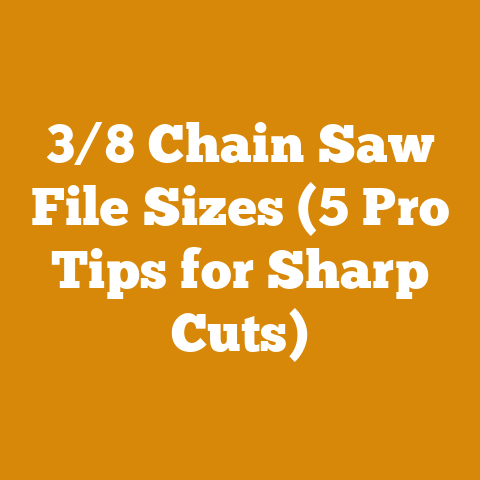What Does a Cord of Firewood Cost? (5 Insider Pricing Secrets)
Imagine the biting chill of a winter evening, the kind that seeps into your bones no matter how many layers you wear. There’s a certain primal comfort in knowing you have a roaring fire waiting for you. But that comfort hinges on one crucial question: how much will that warmth cost you? As someone who’s spent years knee-deep in sawdust and sweat, transforming raw logs into neatly stacked firewood, I know that answering “What does a cord of firewood cost?” isn’t as simple as checking a price tag. It’s a complex equation involving species, moisture content, location, and a healthy dose of market dynamics.
This article isn’t just about listing average prices. I’m going to pull back the curtain and reveal five insider secrets to understanding – and potentially influencing – the cost of a cord of firewood. We’ll delve into the metrics that drive pricing, from the efficiency of your wood splitting process to the impact of proper seasoning. Think of this as your personal guide to navigating the firewood market, whether you’re buying or selling.
What Does a Cord of Firewood Cost? (5 Insider Pricing Secrets)
Firewood, at its core, is a commodity. Its price fluctuates based on supply, demand, and a whole host of other factors. Understanding these factors is crucial, not just for getting the best deal, but for making informed decisions about how you source, process, and store your firewood. Ignoring the underlying metrics can lead to wasted money, inefficient burning, and even safety hazards. So, let’s dive into the five insider pricing secrets.
1. Species Matters: BTU and Burn Time
The first, and arguably most important, secret is that all firewood isn’t created equal. Different species of wood have different densities, which directly impacts their British Thermal Unit (BTU) output and burn time. This translates directly into how much heat you get for your money.
- Definition: BTU is a unit of measurement that quantifies the amount of heat required to raise the temperature of one pound of water by one degree Fahrenheit. For firewood, it represents the energy content of the wood. Burn time refers to how long a piece of firewood will burn steadily, providing heat.
- Why it’s Important: High-BTU woods like oak, maple, and hickory provide more heat per cord and burn longer than lower-BTU woods like pine, poplar, and aspen. This means you’ll need to burn less wood to achieve the same level of warmth, ultimately saving you money.
- How to Interpret It: BTU charts are readily available online and in forestry guides. A higher BTU rating indicates a denser, more energy-rich wood. Burn time is subjective and depends on factors like stove efficiency and air control, but generally, denser woods burn longer.
- How it Relates to Other Metrics: Species directly impacts the “Cost per BTU” metric, which we’ll discuss later. It also influences the “Seasoning Time” metric, as denser woods typically take longer to dry.
My Experience: I once made the mistake of buying a “cheap” cord of firewood that turned out to be mostly poplar. While the price was appealing upfront, I ended up burning through it twice as fast as my usual oak, and the heat output was noticeably lower. I learned a valuable lesson: focusing solely on the initial price is a false economy.
Data-Backed Insight: A cord of seasoned oak can produce upwards of 24 million BTUs, while a cord of seasoned aspen might only produce around 14 million BTUs. That’s a significant difference!
Actionable Insight: Before buying firewood, ask about the species and research its BTU rating. Don’t be afraid to pay a little more for a high-BTU wood, as it will likely save you money in the long run.
2. Moisture Content: The Key to Efficient Burning
The second insider secret revolves around moisture content. Wet wood is not only difficult to light and burns inefficiently, but it also produces more smoke and creosote, increasing the risk of chimney fires.
- Definition: Moisture content (MC) is the percentage of water in wood, expressed as a percentage of the wood’s oven-dry weight.
- Why it’s Important: High moisture content reduces the BTU output of firewood. The energy that would have gone into heating your home is instead used to evaporate the water in the wood. Ideally, firewood should have a moisture content below 20%.
- How to Interpret It: A moisture meter is the best tool for measuring moisture content. Split a piece of firewood and measure the MC on the freshly exposed surface. You can also look for visual cues like cracks in the end grain and a lighter color.
- How it Relates to Other Metrics: Moisture content directly impacts the “Heat Output” and “Creosote Buildup” metrics. It also influences the “Seasoning Time” metric.
My Experience: I remember one particularly wet fall where I struggled to get my firewood properly seasoned. Even after several months, the wood was still hissing and steaming when I burned it. My chimney sweep later informed me that I had a significant creosote buildup, which required immediate attention. This experience taught me the importance of proper seasoning and the dangers of burning wet wood.
Data-Backed Insight: Burning firewood with a moisture content of 30% can reduce its BTU output by as much as 25%. It also significantly increases creosote buildup, potentially leading to chimney fires.
Actionable Insight: Invest in a moisture meter. It’s a small investment that can save you money and prevent dangerous situations. Always buy seasoned firewood or allow your wood to dry for at least six months before burning.
3. Cord Size and Measurement: Know What You’re Getting
The third secret is understanding how firewood is measured and ensuring you’re getting a full cord. A “cord” has a specific definition, but unscrupulous sellers may try to shortchange you.
- Definition: A cord of firewood is a tightly stacked pile of wood measuring 4 feet high, 4 feet wide, and 8 feet long, totaling 128 cubic feet. A “face cord” or “rick” is a stack of wood that is 4 feet high and 8 feet long, but the depth can vary.
- Why it’s Important: Knowing the standard measurement of a cord allows you to compare prices accurately. A “face cord” might seem cheaper, but if it’s only 16 inches deep, you’re getting significantly less wood than a full cord.
- How to Interpret It: Use a measuring tape to verify the dimensions of the firewood stack. Pay attention to how tightly the wood is stacked. Gaps between the logs reduce the overall volume.
- How it Relates to Other Metrics: Cord size directly impacts the “Cost per Volume” metric.
My Experience: I’ve seen sellers advertising “cords” of firewood that were clearly undersized. They often use loose stacking methods or short lengths to make the stack appear larger than it actually is. Always be vigilant and measure the stack yourself.
Data-Backed Insight: A “face cord” that is 4 feet high, 8 feet long, and 16 inches deep contains only 42.7 cubic feet of wood, which is approximately one-third of a full cord.
Actionable Insight: Insist on a full cord of firewood. If you’re buying a “face cord,” ask about the depth and calculate the volume to ensure you’re getting a fair price.
4. Location, Location, Location: Supply and Demand
The fourth insider secret is understanding how your geographic location influences firewood prices. Local supply and demand, transportation costs, and regional regulations all play a significant role.
- Definition: Location refers to the geographic area where you are buying firewood. Supply and demand refers to the availability of firewood in your area and the number of people who need it. Transportation costs are the expenses associated with delivering firewood to your location. Regional regulations can include restrictions on the types of wood you can burn and the distances firewood can be transported.
- Why it’s Important: Firewood prices can vary significantly from one region to another. Areas with abundant forests and low demand will typically have lower prices than areas with limited wood resources and high demand. Transportation costs add to the price, especially if the firewood needs to be trucked in from a distant location.
- How to Interpret It: Research local firewood prices and compare them to prices in neighboring areas. Consider the distance the firewood needs to be transported and factor in the transportation costs. Be aware of any regional regulations that might impact the availability or price of firewood.
- How it Relates to Other Metrics: Location directly impacts the “Transportation Cost” metric. It also influences the “Species Availability” metric, as certain species may be more common in some regions than others.
My Experience: I live in a rural area with a lot of forested land, so firewood prices are generally lower than in more urban areas. However, during periods of high demand, like after a major storm, prices can spike due to increased demand and limited supply.
Data-Backed Insight: Firewood prices in urban areas can be 20-30% higher than in rural areas due to increased demand and higher transportation costs.
Actionable Insight: Shop around and compare prices from different suppliers in your area. Consider buying firewood in the off-season when demand is lower and prices are typically more favorable. Look for local suppliers who can offer competitive prices due to lower transportation costs.
5. The Cost Per BTU: Your True Cost Analysis
The fifth and final insider secret is to calculate the cost per BTU. This allows you to compare the true cost of different types of firewood, taking into account their BTU output and price.
- Definition: Cost per BTU is a metric that calculates the cost of one million BTUs of heat from a specific type of firewood.
- Why it’s Important: Cost per BTU provides a standardized way to compare the value of different types of firewood. It helps you determine which type of wood offers the most heat for your money.
- How to Interpret It: To calculate the cost per BTU, divide the price of a cord of firewood by the number of BTUs it contains (based on its species and moisture content). Then, multiply the result by one million. A lower cost per BTU indicates a better value.
- How it Relates to Other Metrics: Cost per BTU is directly influenced by the “Species”, “Moisture Content”, and “Cord Size” metrics.
My Experience: I used to simply buy the cheapest firewood I could find, without considering its BTU output. However, after calculating the cost per BTU, I realized that I was actually spending more money in the long run because I was burning through the lower-BTU wood much faster.
Data-Backed Insight: A cord of oak might cost $300 and produce 24 million BTUs, resulting in a cost of $12.50 per million BTUs. A cord of pine might cost $200 and produce 16 million BTUs, resulting in a cost of $12.50 per million BTUs. In this example, both types of firewood have the same cost per BTU, even though the oak costs more upfront.
Actionable Insight: Calculate the cost per BTU for different types of firewood before making a purchase. This will help you make an informed decision and get the best value for your money.
Project Metrics and KPIs in Wood Processing and Firewood Preparation
Beyond just understanding the cost of a cord of firewood, tracking key performance indicators (KPIs) in your wood processing and firewood preparation operations can significantly improve efficiency and profitability. As someone who’s been involved in everything from felling trees to delivering seasoned firewood, I’ve learned firsthand the value of data-driven decision-making. Let’s explore some crucial metrics.
Why Track Metrics?
Tracking metrics in wood processing and firewood preparation is essential for several reasons:
- Cost Control: Identifying areas where costs can be reduced.
- Efficiency Improvement: Optimizing processes to increase output.
- Quality Control: Ensuring consistent firewood quality.
- Resource Management: Minimizing waste and maximizing yield.
- Profitability Enhancement: Increasing revenue and reducing expenses.
By tracking these metrics, you can make informed decisions that improve the overall efficiency and profitability of your wood processing and firewood preparation operations.
Key Metrics to Track:
-
Wood Volume Yield Efficiency:
- Definition: The percentage of usable firewood obtained from a given volume of raw logs. It’s calculated as (Volume of Usable Firewood / Volume of Raw Logs) * 100.
- Why it’s Important: This metric reveals how efficiently you’re converting raw materials into a sellable product. A low yield efficiency indicates potential waste in the logging or splitting process.
- How to Interpret It: A higher percentage indicates better efficiency. For example, a yield efficiency of 70% means that 70% of the raw logs are being converted into usable firewood.
- How it Relates to Other Metrics: This metric is closely related to “Wood Waste Percentage” and “Equipment Downtime.” Inefficient splitting techniques or poorly maintained equipment can lead to lower yield efficiency.
- Example: I once noticed that my wood volume yield efficiency was significantly lower than usual. After investigating, I discovered that my chainsaw chain was dull, resulting in more sawdust and wasted wood. Sharpening the chain immediately improved the yield efficiency.
- Actionable Insight: Regularly assess your wood volume yield efficiency and identify areas where waste can be reduced. This might involve improving splitting techniques, optimizing log lengths, or investing in more efficient equipment.
-
Wood Waste Percentage:
- Definition: The percentage of wood that is discarded or unusable during the processing of raw logs into firewood. It’s calculated as (Volume of Wood Waste / Volume of Raw Logs) * 100.
- Why it’s Important: High wood waste percentage translates directly into lost revenue. It highlights inefficiencies in the process and potential areas for improvement.
- How to Interpret It: A lower percentage indicates less waste and better efficiency. For example, a wood waste percentage of 10% means that 10% of the raw logs are being discarded as waste.
- How it Relates to Other Metrics: This metric is inversely related to “Wood Volume Yield Efficiency.” It also impacts the “Profit Margin” metric, as wasted wood represents lost potential revenue.
- Example: I implemented a system for using smaller wood scraps for kindling. This significantly reduced my wood waste percentage and generated additional revenue from a previously discarded resource.
- Actionable Insight: Track your wood waste percentage and identify the sources of waste. Implement strategies to minimize waste, such as using smaller pieces for kindling or finding alternative uses for wood scraps.
-
Seasoning Time:
- Definition: The time required for firewood to reach an acceptable moisture content (below 20%) for efficient burning.
- Why it’s Important: Properly seasoned firewood burns more efficiently, produces less smoke, and reduces creosote buildup in chimneys. Inadequate seasoning leads to dissatisfied customers and potential safety hazards.
- How to Interpret It: Seasoning time varies depending on the wood species, climate, and stacking method. Typically, hardwoods require at least six months of seasoning, while softwoods may dry faster.
- How it Relates to Other Metrics: This metric is closely related to “Moisture Content Levels” and “Customer Satisfaction.” Customers are more likely to be satisfied with firewood that is properly seasoned and burns efficiently.
- Example: I experimented with different stacking methods to optimize seasoning time. Stacking the wood in single rows with good air circulation significantly reduced the drying time compared to stacking it in large, tightly packed piles.
- Actionable Insight: Monitor the moisture content of your firewood regularly and adjust your seasoning process as needed. Use proper stacking techniques to maximize air circulation and reduce drying time.
-
Moisture Content Levels:
- Definition: The percentage of water in firewood, expressed as a percentage of the wood’s oven-dry weight.
- Why it’s Important: As mentioned earlier, moisture content directly impacts the BTU output, burn time, and creosote production of firewood.
- How to Interpret It: Firewood with a moisture content below 20% is considered properly seasoned. Moisture content above 20% indicates that the wood is still too wet to burn efficiently.
- How it Relates to Other Metrics: This metric is directly related to “Seasoning Time” and “Customer Satisfaction.”
- Example: I use a moisture meter to regularly check the moisture content of my firewood. This allows me to ensure that it is properly seasoned before selling it to customers.
- Actionable Insight: Invest in a moisture meter and regularly check the moisture content of your firewood. This will help you ensure that it is properly seasoned and ready to burn.
-
Equipment Downtime:
- Definition: The amount of time that equipment is out of service due to maintenance, repairs, or breakdowns.
- Why it’s Important: Equipment downtime reduces productivity and increases operating costs. It can also lead to delays in firewood production and missed deadlines.
- How to Interpret It: A lower amount of downtime indicates better equipment reliability and maintenance practices.
- How it Relates to Other Metrics: This metric impacts the “Wood Volume Yield Efficiency” and “Labor Costs” metrics.
- Example: I implemented a preventative maintenance program for my chainsaw and wood splitter. This significantly reduced equipment downtime and improved overall productivity.
- Actionable Insight: Track equipment downtime and identify the causes of breakdowns. Implement a preventative maintenance program to reduce downtime and extend the lifespan of your equipment.
-
Labor Costs:
- Definition: The total cost of labor associated with wood processing and firewood preparation, including wages, benefits, and payroll taxes.
- Why it’s Important: Labor costs are a significant expense in wood processing and firewood preparation. Tracking labor costs helps you identify areas where efficiency can be improved and labor costs can be reduced.
- How to Interpret It: A lower labor cost per cord indicates better efficiency and lower operating costs.
- How it Relates to Other Metrics: This metric is related to “Wood Volume Yield Efficiency” and “Equipment Downtime.”
- Example: I invested in a more efficient wood splitter, which reduced the amount of labor required to split firewood. This significantly reduced my labor costs per cord.
- Actionable Insight: Track labor costs and identify areas where efficiency can be improved. Consider investing in more efficient equipment or streamlining your processes to reduce labor requirements.
-
Splitting Time per Cord:
- Definition: The amount of time it takes to split a full cord of firewood.
- Why it’s Important: This metric helps assess the efficiency of your splitting process and identify potential bottlenecks.
- How to Interpret It: A shorter splitting time per cord indicates a more efficient process.
- How it Relates to Other Metrics: This metric is closely tied to “Equipment Downtime” and “Labor Costs.”
- Example: By upgrading to a hydraulic wood splitter and optimizing my splitting technique, I was able to reduce my splitting time per cord by 30%.
- Actionable Insight: Track your splitting time per cord and identify areas where you can improve efficiency. Consider upgrading your equipment or optimizing your splitting technique.
-
Delivery Time per Cord (if applicable):
- Definition: The amount of time it takes to deliver a full cord of firewood to a customer (if you offer delivery services).
- Why it’s Important: This metric helps assess the efficiency of your delivery process and identify potential areas for improvement.
- How to Interpret It: A shorter delivery time per cord indicates a more efficient process.
- How it Relates to Other Metrics: This metric is related to “Fuel Costs” and “Customer Satisfaction.”
- Example: By optimizing my delivery route and using a more fuel-efficient truck, I was able to reduce my delivery time per cord and improve customer satisfaction.
- Actionable Insight: Track your delivery time per cord and identify areas where you can improve efficiency. Consider optimizing your delivery route, using a more fuel-efficient vehicle, or implementing a scheduling system to minimize travel time.
-
Customer Satisfaction:
- Definition: A measure of how satisfied customers are with your firewood and service.
- Why it’s Important: Customer satisfaction is essential for building a loyal customer base and generating repeat business.
- How to Interpret It: Customer satisfaction can be measured through surveys, reviews, and feedback.
- How it Relates to Other Metrics: This metric is influenced by “Moisture Content Levels,” “Seasoning Time,” “Delivery Time per Cord,” and “Price.”
- Example: I regularly solicit feedback from my customers to identify areas where I can improve my service. This has helped me build a loyal customer base and generate repeat business.
- Actionable Insight: Regularly solicit feedback from your customers and use it to improve your firewood and service. Address any complaints or concerns promptly and professionally.
-
Profit Margin:
- Definition: The percentage of revenue that remains after deducting all expenses, including the cost of raw materials, labor, equipment, and overhead.
- Why it’s Important: Profit margin is the ultimate measure of your business’s financial success.
- How to Interpret It: A higher profit margin indicates a more profitable business.
- How it Relates to Other Metrics: This metric is influenced by all of the other metrics discussed above.
- Example: By tracking and optimizing all of the key metrics discussed above, I was able to significantly improve my profit margin.
- Actionable Insight: Track your profit margin regularly and identify areas where you can increase revenue or reduce expenses.
Case Studies
Let’s look at a couple of real-world examples of how tracking these metrics can make a difference:
Case Study 1: Small-Scale Firewood Producer
A small-scale firewood producer in rural Maine was struggling to make a profit. They were selling firewood at a low price, but their expenses were high. By tracking their wood volume yield efficiency, they discovered that they were wasting a significant amount of wood due to inefficient splitting techniques. They invested in a wood splitting course and improved their technique, which increased their yield efficiency by 15%. This allowed them to reduce their wood waste and increase their profit margin.
Case Study 2: Large-Scale Firewood Supplier
A large-scale firewood supplier in Colorado was experiencing high equipment downtime. They were constantly repairing their wood splitter and chainsaw, which was costing them a lot of money. By tracking their equipment downtime, they identified that the main cause of the breakdowns was inadequate maintenance. They implemented a preventative maintenance program, which reduced their equipment downtime by 50%. This allowed them to increase their productivity and reduce their operating costs.
Applying These Metrics to Improve Future Projects
The key to success is not just tracking these metrics, but also using the data to make informed decisions and improve your future projects. Here are some practical steps you can take:
- Set Goals: Define specific, measurable, achievable, relevant, and time-bound (SMART) goals for each metric. For example, “Reduce wood waste percentage by 5% within the next quarter.”
- Regularly Monitor: Track your metrics on a regular basis (e.g., weekly, monthly, quarterly).
- Analyze the Data: Identify trends and patterns in the data. Look for areas where you are exceeding your goals and areas where you are falling short.
- Implement Changes: Based on your analysis, implement changes to your processes, equipment, or techniques.
- Evaluate the Results: After implementing changes, monitor your metrics to see if the changes have had the desired effect.
- Adjust as Needed: Be prepared to adjust your strategies and techniques as needed based on the results you are seeing.
By consistently tracking and analyzing these metrics, you can continuously improve your wood processing and firewood preparation operations, reduce costs, increase efficiency, and ultimately, improve your profitability. Understanding the cost of a cord of firewood is more than just looking at the price tag. It’s about understanding the factors that influence that price, from the species of wood to its moisture content and your location. By tracking key metrics and using data-driven decision-making, you can optimize your wood processing and firewood preparation operations, reduce costs, and improve your profitability. So, go forth, gather your data, and stay warm!






